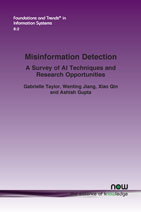Misinformation Detection: A Survey of AI Techniques and Research Opportunities
By Gabrielle Taylor, MultiPlan Inc, USA, gabrielle.taylor@multiplan.com | Wenting Jiang, Oklahoma State University, USA, kayla.jiang@okstate.edu | Xiao Qin, Auburn University, USA, xqin@auburn.edu | Ashish Gupta, Auburn University, USA, azg0074@auburn.edu
Abstract
This survey highlights the evolution of techniques within misinformation detection. Misinformation has become increasingly prevalent on the Internet by the day and progressively more threatening. Individuals who are inaccurately informed tend to make misinformed decisions which have led to voting scandals, traffic accidents, and even health concerns. We are motivated to address a research gap by analyzing misinformation detection’s overall progress and exposing the weaknesses that provide research opportunities. Our findings will further advance the work of misinformation detection and bring light to unique ways to tackle the issue. Notably, we discuss the significance of misinformation detection systems and present the problems resulting from misinformation, the techniques for detection, and open issues within this research. Misinformation is becoming an issue that requires more attention and improved systems. We believe that our systematic review and synthesis of state-of-art research will cultivate a path for these developments.
Misinformation Detection: A Survey of AI Techniques and Research Opportunities
Misinformation Detection: A Survey of AI Techniques and Research Opportunities highlights the evolution of techniques within misinformation detection. This monograph provides an overview of the types of misinformation, classification strategies, strengths and weaknesses, and potential solutions for open issues. This comprehensive survey is helpful for future research as a resource for successful solutions and possible ideas. The authors first present background information including search strategies in Sections 1 and 2 and identify the types of misinformation in Section 3. The monograph then elaborates on the methods and compares the existing successful techniques from various perspectives in Section 4. Section 5 provides tools and datasets for misinformation detection. Section 6 reviews the challenges and open issues of misinformation and makes suggestions on how one can address those challenges. The monograph concludes in Section 7 with final thoughts on the areas of misinformation detection and an overall analysis of this field.
